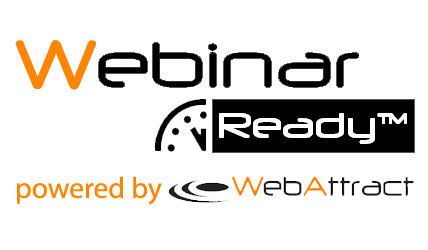
Webinars continue to be an invaluable content marketing tool for companies to attract and engage with prospects as well as retain existing customers to become your advocates. They are theatrical, like a radio show with pictures, that allows you tell a story beyond sound bites with real business outcomes.
Over the last eight years, my team and I have planned, produced, delivered, and moderated hundreds of webinars across a wide canvas of B2B industries. In many cases, we’ve seen how a well-produced and delivered webinar can move prospects off the fence to become new customers as well as help measure their intent to purchase as a result of attending the webinar.
In this post, I’m going to share my most important lessons learned for planning a webinar that people want to attend. We’ll cover how to attract your audience and in the following posts in this series, we’ll cover how to engage and convert your audiences into customers.
Before You Begin
First, in order to effectively attract your webinar audience, you must understand that most registrants and attendees are not “sales ready” at this point. Instead, they are on a journey to become better informed and better educated. They don’t want to feel like they are attending a sales pitch, or that you are asking them to attend one. They want to know how you can solve their problems.
To attract an audience, it is your challenge to:
- Identify their challenges and pain points.
- Determine how you can help them solve their challenge.
- Effectively communicate this before and during the webinar—in your email invitations, on your registration landing page, and through your speakers and PowerPoint slides.
In this way, attendees can eventually become your customers and future advocates. Now let’s get into more specifics on how you can plan and ensure you attract your desired audience
1. Choose a Relevant Topic
Is your topic a “must have” that will educate the audience on how to overcome a pain point or demonstrate how they will achieve better outcomes? People won’t register if it’s not specific or if it doesn’t provide content that will help them overcome a vexing challenge. Remember, people buy when they are in pain and have money to solve it.
A great example of a relevant topic comes from a recent case study webinar covering a large automobile dealership. The dealership, using an innovative software solution, increased new vehicle gross profits and sales by discussing their challenges, options to solving these challenges, methodology used, business outcomes, lessons learned, and how to get started.
The webinar, titled Conquest Case Study: How Performance Toyota Increased new Vehicle Gross Profits and Sales, addressed a real pain point for automobile dealers; it attracted about 600 influencers and decision makers! This resulted in over 180 leads, of which 30 were closed, resulting in over $400,000 in annual incremental revenue.
An example of some other must-have topics that have proven to be very successful in attracting an audience are described below. (By the way, two of these led to a million dollar sale—can you guess which ones they are?)
- “Case Study: How Merck is Using Virtual Team Building to Increase Performance”
- “How Active Rehab Protocols Reduce Post-Operative Recovery Time”
- “Smarter Streets: Case Studies for Cities and Utilities – Learn How the City of Baltimore and Washington Gas Reduced Costs”
- “Separating the Contenders from the Pretenders in the World of Oil Water Separation”
- “Culture Shock: Shake-Up Your Company, Your Store, Your People and Sales Increases Will Follow”
2. Use Industry Disruption to Your Advantage
Industries in turmoil, or ones dealing with confusion and change, are ripe for attending a webinar to learn how to overcome these challenges. Webinars that address these issues do very well in attracting their audiences. All of the examples above, in one way or another, were dealing with disruption from industry changes of markets, standards, or legal compliance shifts.
For example, we continue to see a very strong audience acquisition outcome in sectors dealing with disruption, such as Aerospace, Automotive, Healthcare, and Life Sciences. These industries continually attract between 250 and 950 registrants, with attendance ratios above 50%, that retain over 80% of the peak audience well into the start of the live Q/A panel.
3. Develop an Audience Profile That Aligns With Your Topic and Value Proposition
Start with asking yourself, “If I received an invitation to my webinar, is the value proposition clear enough that I’d want to attend?” Create a list of priorities of which industries, markets, or types of buyers would most benefit from this topic that also align with your desired business outcomes. For example, beyond identifying these five key demographics (industries, job titles, job levels, revenue thresholds, and geographies), keep refining which job titles and functions your webinar would appeal to the most.
We did a webinar for a company that specializes in providing light-curable materials (LCMs) and wanted to educate the audience on the business benefits of using these LCMs to reduce costs, improve safety, and increase energy savings. By refining the demographics, we not only identified 10 top industries, but we were also able to determine the job titles most ripe to learn about why LCMs provide advantages over traditional methods. It would have been easy to simply target titles with manufacturing or engineering in them, but we would have not aligned the topic and value proposition to the right persona.
4. Consider External Thought Leaders as Speakers
The credibility of a webinar significantly increases when at least one of the speakers is not affiliated with the company sponsoring the webinar. A thought leader or third party expert is critical in attracting an audience. During the webinar, they can call upon real life examples to educate the audience, as well as share trends and opportunities to overcome key challenges. Done right, real thought leaders will inspire attendees who are interested in learning more to contact the webinar sponsor after the webinar.
We did a webinar for a very well-known brand that chose their sales vice president as one of the presenters along with an internal engineer, and it fell flat. While they were knowledgeable, lacking a credible third party speaker made the event sound like a corporate sales pitch. When an industry analyst, editor, or thought leader unaffiliated with the webinar sponsor is involved, it will appear less like a sales pitch and motivate people to register and attend.
5. Gather and Mine Actionable Life Cycle Intelligence
Any project, initiative, or event has three critical success factors that must be managed and monitored throughout its life cycle to meet or exceed your commercial outcomes:
- A proven, deadline-driven methodology.
- A set of ever-evolving best practices.
- Appropriate metrics or KPIs (key performance indicators) to benchmark and predict outcomes before, during, and after the event.
What gets measured, gets done. Key email and webinar performance metrics can tell you if you’re on track to meet your goals. If you’re not, they’ll help you diagnose what mid-course changes need to be made long before you meet your virtual audience.
Knowing your email delivery rates provides insight into how well your lists are performing, revealing any differences between the number sent and the number delivered. Open rates provide insight into the effectiveness of your topic and subject lines. Unsubscribe rates tell you whether or not you are addressing the right audience demographics.
Your best early indicator of webinar success is comparing how many people are registering to those that actually click on the registration page (your click through rate). It will predict with uncanny accuracy what type of registration and attendance you can expect. A CTR above 25% is a strong indicator your message is resonating. A low performing CTR, in the teens, might indicate problems with your landing page appeal, as well as your overall messaging and value proposition.
Other life cycle intelligence to collect includes demographic information—which industries, job titles/functions, and geographies are registering—as well as what sources, such as email marketing or social media, are driving registrations.
Perhaps the most important intelligence you can gather is simply asking people when they register, “What do you want to learn from this webinar?” It’s better to learn this before they show up on webinar day, as it helps validate the messaging and deliverables you promised to cover in the invitation. More importantly, you can share this information with your speakers to make sure they align their presentation with the interests of the audience.
(And these are only the webinar performance metrics to look at before the webinar! There are many other metrics that are used during and after the webinar that I plan to cover in my next post.)
While these lessons only scratch the surface, following them will ensure you meet and exceed your commercial goals while adding value to your audience. Good content marketing is about making your attendees more intelligent, so they can make more informed decisions and choose you as their vendor or partner.
Finally, there are two important confessions to remember: The first is that your attendees are on a journey—resist the temptation to sell during the webinar. The time to sell is after the webinar is over,1 as you can use all of the life cycle intelligence and metrics collected before, during, and after the webinar to determine who is sales ready, who needs more is nurturing, and who is not a fit.
The second confession is that planning a webinar has a lot of moving parts, and setting the stage for a smooth webinar production is critical for success. As many webinars as we’ve produced, we know that while planning a webinar is time-consuming, taking shortcuts is not an option. If you fail to plan, you plan to fail.
Here’s to your webinar success!
 To learn more, consider enrolling in our Master Webinar Producer Training Course where you’ll learn everything you need to know to attract, engage, and convert webinar prospects into customers and get a certification to prove it.
To learn more, consider enrolling in our Master Webinar Producer Training Course where you’ll learn everything you need to know to attract, engage, and convert webinar prospects into customers and get a certification to prove it.
This article originally appeared on Convince&Convert as “5 Expert Tips for Attracting Your Webinar Attendance”.
[…] Confessions of an Executive Webinar Producer Part 1: Top Lessons Learned for Attracting Your Webinar… […]
[…] Planning a Webinar That People Want to Attend: Lessons Learned After Producing Over 400 Webinars […]
[…] Planning a Webinar That People Want to Attend: Lessons Learned After Producing Over 400 Webinars […]